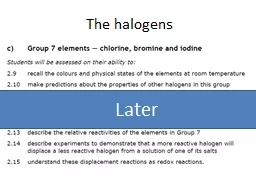

Later Group 7 The Halogens Physical Properties Simple Molecular Structures Diatomic molecules Strong covalent b onds Weak intermolecular forces Low melting and boiling points Poor conductors of heat and electricity ID: 302158
Download Presentation The PPT/PDF document "The halogens" is the property of its rightful owner. Permission is granted to download and print the materials on this web site for personal, non-commercial use only, and to display it on your personal computer provided you do not modify the materials and that you retain all copyright notices contained in the materials. By downloading content from our website, you accept the terms of this agreement.
Slide1
The halogens
LaterSlide2
Group 7
The HalogensSlide3
Physical Properties
Simple Molecular StructuresDiatomic moleculesStrong covalent bondsWeak intermolecular forces
Low melting and boiling points
Poor conductors of heat and electricity
Melting point and boiling point increase as you go down the group.Slide4
Chemical Properties
of the HalogensAll have 7 electrons in their outer shell.They all want to gain one more electron for a full outer shell. There are two ways they can do this:
Ionic bonding – Accept
one
electron from a metal atom to become a halide ion with a -1 charge.Covalent bonding – Form one covalent bond with another non-metal.Slide5
Examples
Ionic Bonding2Na + Cl2 2NaCl
Ca + F
2
CaF2
Na
+
Cl
-
xo
xx
xx
xx
Ca
2+
F
-
xo
xx
xx
xx
F
-
xo
xx
xx
xxSlide6
Examples
b) Covalent BondingHCl
Cl
2Slide7
Reactivity decreases as you go down group 7
Reaction
Conditions
F
2(g) + H
2(g) → 2HF
(g)
Explosive
even at -200
o
C in the dark.
Cl
2(g)
+ H
2(g)
→ 2HCl
(g)
Explosive in sunlight.
S
low
in the dark.
Br
2(g)
+ H
2(g)
→ 2HBr(g)
300
oC + Pt catalyst
I
2(g) + H
2(g) → 2HI
(g)
Very slow at 300o
C with Pt catalystSlide8
Group 7 –
forming negative ions
Reactivity decreases as you go down the group.
In larger atoms the
outermost
electrons are further from the nucleus.
This makes it harder to gain an electron as it will be less
strongly
attracted
to the
nucleus
REACTIVITY INCREASES
Cl
FSlide9
Halogen displacement reactions
Miss
Iodide
Mr
Sodium
Sodium Iodide
Miss
Bromine
+
+
Bromine
Mr
Sodium
Sodium Bromide
+
Iodine
Miss
Bromide
Miss
Iodine
2NaI
(
aq
)
+
Br
2(
aq
)
2NaBr
(
aq
)
+
I
2(
aq
)
Iodide oxidised
Bromine reducedSlide10
Halogen displacement reactions
Miss
Potassium
Mr
Bromide
Mr
Chlorine
+
Miss
Potassium
Mr
Bromine
Mr
Chloride
Potassium Bromide
+
Chlorine
Potassium Chloride
+
Bromine
2KBr
(
aq
)
+
Cl
2(
aq
)
2KCl
(
aq
)
+
Br
2(
aq
)
Bromide oxidised
Chlorine reducedSlide11
What if we add fluorine to aqueous potassium chloride?
Fluorine is more reactive than chlorine so would displace chloride from it’s salt.
However, fluorine is so reactive it would instantly react with the water before it got to the chloride ions!Slide12
Cl
F